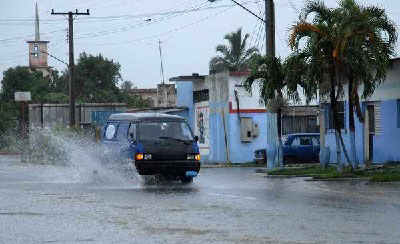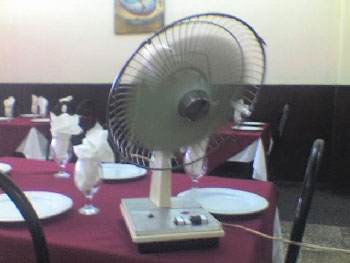Pinar del Rio: The Ravishes of Time (I)
Vicente Morin Aguado

HAVANA TIMES — When I write of the “weathered” streets of Pinar del Rio, I am thinking, not of the effects of climate, but about the onslaught of time itself, about the “implacable passage of time, the time that passed”, to quote songwriter Pablo Milanes.
My trip to Cuba’s westernmost province was, to be geographically precise, an incursion into the western end of Cuba’s Havana-Matanzas plain. From the unavoidably cold of a refrigerated Yutong bus, I looked out at my immediate surroundings as we neared our destination, past puddles, lakes and rivers that had burst their banks.
The bad weather, which had shrouded even the summit of the Sierra del Rosario in fog, did not prevent us from arriving on time at Pinar del Rio’s capital.
The city, to be sure, did not exactly offer me a warm welcome. It would admittedly have been too much to ask for, considering an official weather alert had been issued in connection with the intense rains.
That said, the proverbial kindness of Pinar folk had not been dampened by the news and the locals were quick to assist me in finding adequate accommodations. Things have changed some in this connection: now, many people rent out rooms by the hour, catering to those forced to satisfy their passions furtively and, if you’re looking to stay longer, there’s also a price per night. If you’re a run-of-the-mill Cuban, not of the tourist persuasion, then the figure does not look pretty.
I’ll spare you the details about how I ended up at the El Globo hotel – in the immensely wise words of Garcia Lorca, “the light of reason compels me to be very discrete in my pronouncements.”
I’ll be a tad bold and relate that, in Havana, one of the bus employees almost took me in his arms and carried me to the Yutong like a baby, so delighted was he with the two-Cuban-Convertible-Peso tip I gave him when he handed me my bus ticket. I didn’t have time to go the bathroom or to buy anything to eat or drink during the journey.
The manager of El Globo wasn’t too fond of me. We people from Havana have the reputation of being hypercritical. To appease him, I assured him I would not say anything derogatory about his old, ramshackle hotel.

Well, it’s not really “his” hotel – it’s just a manner of speaking. I couldn’t exactly complain, either: it offered me a bed and a safe environment for the equivalent of one Cuban Convertible peso a day, while most private lodgings cost eight, as a minimum.
In the evening, I went out for a stroll down Marti Street. Every main street in every town in Cuba’s interior is named “Marti”. When I write “town”, I may well be offending the people of Pinar del Rio, who would doubtless prefer to read the word “city”. In my humble opinion, Havana is Cuba’s one and only true city.
Just about everything of any importance in the town is located on this street: banks, shops, restaurants and other establishments. It seems as though the whole of Pinar del Rio is condensed into that long thoroughfare, lined with old, colonial buildings, like the ones you see in the neighborhood of Centro Habana in Cuba’s capital, much frequented by Cubans and foreigners alike.
The purpose of my trip was to glimpse life in the province through its press. When I got to the public library, I found out it was closed for repairs (the old building has serious water leakages). The city archives, though officially in operation, were also closed, owing to damages caused by the intense rains. The local newspaper (Guerrillero is its name), housed in a modern building, was the only institution that was able to offer me the assistance I needed.
It was supper time and, walking down Marti Street, I got to a hotel named La Marina. There were no rooms available, owing to the building’s poor structural condition. In the lobby, however, there was a restaurant offering food and drinks at reasonable prices in regular Cuban pesos.
During my walk around the city, I saw, and was told, that other old hotels around town are in the same condition. El Globo was a rare exception (though I still have much to say about the state of its accommodations).
I was finally approached by a kind waitress (blessed, as most women in Pinar del Rio, with a beautiful pair of calves), who served me the quickly-prepared, well-cooked food. I asked for a local beer, brand-named Princesa in reference to pre-revolutionary times, when this province on the western end of the island was christened by newspapers as “Cuba’s Cinderella”.
It was not until I looked up (away from the shapely legs of my young waitress) and fixed my gaze on the restaurant’s central column, located right in front of my table, that I realized I was in Pinar del Rio.

Four fans were being used to ventilate the modest establishment. This, in and of itself, is nothing out of the ordinary in Cuba. What is – and I shall do my best to illustrate this point – is the fact these were four Wahson-brand fans, fans made in China many years ago, maybe as many as forty, if we go back to their first and only appearance in the island’s history.
Their durability and capacity to survive just about any accident earned Wahson fans a formidable reputation back in the day. They’re built out of pure steel, like the General Electric fans one sees in Al Capone movies.
Their blades are also made of steel, and fastened to the central piece with a conical nickelled thread. A long, metallic cone protects the motor, which was made to last. If you get into a quarrel with your wife and she picks up a Wahson fan, you best run.
How these Chinese fans made it to Cuba in the sixties, when the island may have enjoyed a brief season of good relations with Mao Tse-Tung’s China, is beyond me. I write Mao with the spelling of the time, when people spoke of Peking, not Beijing.
We had a small Wahson fan at home which lasted my entire childhood, youth and first marriage. We never once had to have it repaired. My mother died but the fan continued to blow air. The Chinese made quality products at the time.
Emptying my second pint of Princesa, I think about Cuba’s only manufacturer of electrical appliances, popularly known by an acronym which has been turned into a registered trademark: INPUD.
Che Guevera founded this company in the province of Santa Clara (during his brief time as Minister of Industry). What’s curious is that INPUD didn’t manufacture fans, indispensable appliances in a hot, tropical country like ours.
I’ll never forget the sixties, when I got married and was in need of a fan powerful enough to ventilate my nuptial quarters. You couldn’t find them on sale anywhere, but skillful folk would build them using electrical motors (which were generally too large from the point of view of an optimal fan design). These fans were extremely practical, and many of us cooled our quarters using these homemade contraptions.
As I finish my meal at La Marina, on Marti Street, in the city of Pinar del Rio, I watch the four, illustrious Wahson fans, heroic appliances that have survived Mao and Deng Xiaoping, ventilate the establishment, forty years after arriving in Cuba.
To be continued…
Vicente Morín Aguado: [email protected]





